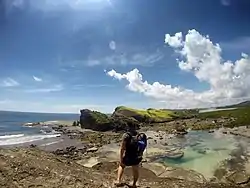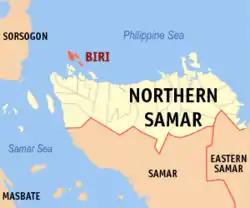Biri, Northern Samar
Biri, officially the Municipality of Biri (Waray: Bungto han Biri; Tagalog: Bayan ng Biri), is a 5th class municipality in the province of Northern Samar, Philippines. According to the 2020 census, it has a population of 11,274 people.[3]
Biri | |
|---|---|
| Municipality of Biri | |
 Bel-at and Tidal pool part of Biri Rock Formation | |
 Flag | |
 Map of Northern Samar with Biri highlighted | |
OpenStreetMap | |
.svg.png.webp) Biri Location within the Philippines | |
| Coordinates: 12°40′N 124°23′E | |
| Country | Philippines |
| Region | Eastern Visayas |
| Province | Northern Samar |
| District | 1st district |
| Barangays | 8 (see Barangays) |
| Government | |
| • Type | Sangguniang Bayan |
| • Mayor | Antonio B. Delos Reyes, Jr. |
| • Vice Mayor | Ana B. Araojo |
| • Representative | Paul R. Daza |
| • Councilors | List |
| • Electorate | 9,511 voters (2022) |
| Area | |
| • Total | 24.62 km2 (9.51 sq mi) |
| Elevation | 1.0 m (3.3 ft) |
| Highest elevation | 189 m (620 ft) |
| Lowest elevation | −1 m (−3 ft) |
| Population (2020 census)[3] | |
| • Total | 11,274 |
| • Density | 460/km2 (1,200/sq mi) |
| • Households | 2,485 |
| Economy | |
| • Income class | 5th municipal income class |
| • Poverty incidence | 41.78 |
| • Revenue | ₱ 81.9 million (2020) |
| • Assets | ₱ 178.6 million (2020) |
| • Expenditure | ₱ 439.1 million (2020) |
| • Liabilities | ₱ 35.22 million (2020) |
| Service provider | |
| • Electricity | Northern Samar Electric Cooperative (NORSAMELCO) |
| Time zone | UTC+8 (PST) |
| ZIP code | 6410 |
| PSGC | |
| IDD : area code | +63 (0)55 |
| Native languages | Waray Tagalog |
The archipelagic town is also known for its inakob, a traditional Waray dish made by first cooking grated root crops (gabi) with coconut milk, condensed milk, eggs, brown sugar, and an herb called anuv. Once cooked, the grated gabi is put inside gabi shells which have been peeled. The dish is then boiled with coconut milk. The dish is traditionally eaten hot by the people of Biri during the rainy months.[5]
Geography
The municipality is facing Pacific Ocean to the east and San Bernardino Strait to the west. It consists of several islands off the northern coast of Samar Island, the largest of which is Biri Island. Other larger islands are Talisay, Magasang, and Cagnipa. Biri Island is notable for a large number of unusual rock formations along the northern shore, facing the Philippine Sea. It is included in the marine protected area known as Biri Larosa Protected Landscape and Seascape.
Barangays
Biri is politically subdivided into 8 barangays. Each barangay consists of puroks and some have sitios.
- Poblacion (Biri)
- MacArthur
- Kauswagan (Basud)
- Pio Del Pilar
- Progress or Talisay
- San Antonio
- San Pedro
- Santo Niño (Palhugan)
Climate
| Climate data for Biri, Northern Samar | |||||||||||||
|---|---|---|---|---|---|---|---|---|---|---|---|---|---|
| Month | Jan | Feb | Mar | Apr | May | Jun | Jul | Aug | Sep | Oct | Nov | Dec | Year |
| Average high °C (°F) | 27 (81) |
28 (82) |
29 (84) |
30 (86) |
31 (88) |
30 (86) |
29 (84) |
29 (84) |
29 (84) |
29 (84) |
29 (84) |
28 (82) |
29 (84) |
| Average low °C (°F) | 22 (72) |
22 (72) |
22 (72) |
22 (72) |
24 (75) |
24 (75) |
24 (75) |
24 (75) |
24 (75) |
24 (75) |
23 (73) |
23 (73) |
23 (74) |
| Average precipitation mm (inches) | 84 (3.3) |
59 (2.3) |
58 (2.3) |
55 (2.2) |
93 (3.7) |
133 (5.2) |
149 (5.9) |
125 (4.9) |
155 (6.1) |
165 (6.5) |
140 (5.5) |
136 (5.4) |
1,352 (53.3) |
| Average rainy days | 18.1 | 13.6 | 15.8 | 16.1 | 21.7 | 25.5 | 26.6 | 25.1 | 24.8 | 25.8 | 22.7 | 20.1 | 255.9 |
| Source: Meteoblue[6] | |||||||||||||
Demographics
| Year | Pop. | ±% p.a. |
|---|---|---|
| 1970 | 5,577 | — |
| 1975 | 6,517 | +3.17% |
| 1980 | 7,437 | +2.68% |
| 1990 | 7,467 | +0.04% |
| 1995 | 8,866 | +3.27% |
| 2000 | 8,700 | −0.40% |
| 2007 | 10,649 | +2.83% |
| 2010 | 10,987 | +1.14% |
| 2015 | 11,767 | +1.31% |
| 2020 | 11,274 | −0.84% |
| Source: Philippine Statistics Authority[7][8][9][10] | ||
Economy
Mangrove reforestation
In 2007, the Community-Based Mangrove Protection and Management project was implemented in Biri, funded by the Philippine Tropical Forest Conservation Foundation (PTFCF). The project aimed to contribute to the regeneration of the mangrove ecosystem by establishing a community-based mangrove management system. The project covered protection of 546 hectares and enhancement planting in 39 hectares. As of 2013, it has been expanded to all eight barangays in Biri.[18]
Biri Initiative Org.
In 2012, a non-profit organization, Biri Initiative Org., was registered with the Philippine Securities and Exchange Commission. Its main objectives are to restore areas of coral reef damaged by illegal fishing methods, promote sustainable and environment-friendly methods of fishing, and encourage opportunities for alternative livelihoods, particularly for women.[19]
References
- Municipality of Biri | (DILG)
- "2015 Census of Population, Report No. 3 – Population, Land Area, and Population Density" (PDF). Philippine Statistics Authority. Quezon City, Philippines. August 2016. ISSN 0117-1453. Archived (PDF) from the original on May 25, 2021. Retrieved July 16, 2021.
- Census of Population (2020). "Region VIII (Eastern Visayas)". Total Population by Province, City, Municipality and Barangay. Philippine Statistics Authority. Retrieved 8 July 2021.
- "PSA Releases the 2018 Municipal and City Level Poverty Estimates". Philippine Statistics Authority. 15 December 2021. Retrieved 22 January 2022.
- Kapuso Mo, Jessica Soho: Comfort food ng mga Waray. YouTube. Archived from the original on 2021-12-11.
- "Biri, Northern Samar : Average Temperatures and Rainfall". Meteoblue. Retrieved 6 January 2019.
- Census of Population (2015). "Region VIII (Eastern Visayas)". Total Population by Province, City, Municipality and Barangay. Philippine Statistics Authority. Retrieved 20 June 2016.
- Census of Population and Housing (2010). "Region VIII (Eastern Visayas)" (PDF). Total Population by Province, City, Municipality and Barangay. National Statistics Office. Retrieved 29 June 2016.
- Censuses of Population (1903–2007). "Region VIII (Eastern Visayas)". Table 1. Population Enumerated in Various Censuses by Province/Highly Urbanized City: 1903 to 2007. National Statistics Office.
- "Province of Northern Samar". Municipality Population Data. Local Water Utilities Administration Research Division. Retrieved 17 December 2016.
- "Poverty incidence (PI):". Philippine Statistics Authority. Retrieved December 28, 2020.
- "Estimation of Local Poverty in the Philippines" (PDF). Philippine Statistics Authority. 29 November 2005.
- "2003 City and Municipal Level Poverty Estimates" (PDF). Philippine Statistics Authority. 23 March 2009.
- "City and Municipal Level Poverty Estimates; 2006 and 2009" (PDF). Philippine Statistics Authority. 3 August 2012.
- "2012 Municipal and City Level Poverty Estimates" (PDF). Philippine Statistics Authority. 31 May 2016.
- "Municipal and City Level Small Area Poverty Estimates; 2009, 2012 and 2015". Philippine Statistics Authority. 10 July 2019.
- "PSA Releases the 2018 Municipal and City Level Poverty Estimates". Philippine Statistics Authority. 15 December 2021. Retrieved 22 January 2022.
- "Philippine Tropical Forest Conservation Foundation". Retrieved 22 September 2013.
- "Biri Initiative". Retrieved 22 September 2013.